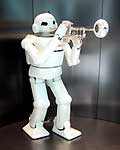With the development of urban areas, high-rise buildings have been increasingly sprouting up in recent years, and a new profession has emerged in Vietnam – the job of cleaning windows on skyscrapers. However, cleaning windows manually is time-consuming, labor-intensive, and especially dangerous for workers who often have to work at great heights.
 |
|
(Image: VTV) |
To address this issue, instructors and students from Lac Hong University in Dong Nai Province have conceived the idea of designing and creating an industrial robot for cleaning windows in high-rise buildings.
With the primary task of cleaning high-rise windows, the robot is not only capable of moving on horizontal surfaces but also on vertical planes while carrying the necessary equipment to perform cleaning, inspection, and maintenance tasks.
Master Nguyen Vu Quynh, a lecturer at the Faculty of Mechanical and Electrical Engineering at Lac Hong University, stated: “Moving on vertical surfaces is significantly more difficult than moving on horizontal ones. Based on the principle of sliding on two bodies, when one part of the robot is securely attached to the glass, the second part will slide up. By doing this, at least 50% of the robot’s suction cups are always adhered to the glass, preventing the robot from falling.”
According to the design, the robot utilizes a ball screw mechanism to achieve translational motion in two perpendicular directions, employs a tail stabilization mechanism to maintain its center of gravity, and incorporates limit switches and warning alarms to detect glass edges while using hot steam to assist with the cleaning component. After more than a year of development and testing, the results show that the robot operates effectively, moving steadily in both vertical and horizontal directions, overcoming ledges, and cleaning glass thoroughly.
According to Dr. Tran Hanh, the President of Lac Hong University and the project leader: “The window cleaning robot can climb 10 meters per hour and move horizontally about 7-8 meters (approximately 80 m2). It is slightly slower than a human, but much safer. As the height increases, the risk to human workers also escalates.”
Not only does this robot replace humans in the task of cleaning high-rise windows, helping to eliminate unnecessary risks, but it also offers the advantage of a one-time investment. Owners of high-rise buildings can utilize the robot for years in window cleaning, saving time, effort, and costs. Going forward, Lac Hong University will collaborate with the Dong Nai Department of Science and Technology to bring the window cleaning robot into industrial production to meet the needs of consumers nationwide.

















































